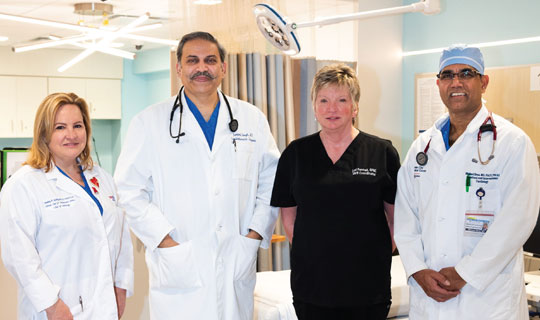
The TAVR team at Jersey City Medical Center includes (from left) Kimberly Skelding, MD; Deepak Singh, MD; Lori Pennell, APNC; and Michael Benz, MD.
A new approach further advances a minimally invasive heart treatment.

FACC, FAHA, FSCAI
Call it an innovation of an innovation: Jersey City Medical Center (JCMC) is among the few world-class facilities in the region to use a highly specialized approach for an already advanced cardiac procedure.
The advanced procedure, called transcatheter aortic valve replacement (TAVR), is a minimally invasive way to treat the heart’s aortic valve. It entails accessing the heart using a catheter (tube) threaded through an artery rather than opening the chest and accessing the heart through an incision.
TAVR procedures most commonly access the heart through an artery in the groin. But recent advancements have introduced alternative access sites. One highly specialized innovation is to access the heart using a catheter inserted through the carotid artery in the neck.
“Traditionally, the femoral artery in the groin is the preferred access point for TAVR,” says Kimberly Skelding, MD, Division Chief of Cardiovascular Services at JCMC. “However, some patients have blockages or other issues in this area that make this approach unsuitable. For these patients, the carotid artery access becomes a critical alternative.”

Minimizing Risks
The innovative procedure using the carotid artery approach was performed in the hospital’s cardiac catheterization laboratory on a patient with severe symptomatic aortic stenosis, a narrowing of the aortic valve that restricts blood flow.
Michael Benz, MD, Medical Director of the Structural Program in Hudson County at JCMC, along with Dr. Skelding and Deepak Singh, MD, Division Chief of Cardiothoracic Surgery and Surgical Director of Advanced Heart Failure and Mechanical Circulatory Support at JCMC, performed the procedure.
The patient went home within 48 hours and enjoyed a quick recovery with minimal discomfort—and lower overall risk of complications.

“Stroke is a potential complication associated with TAVR, and the carotid artery approach minimizes this risk, providing a safer option for high-risk patients who wouldn’t be candidates for traditional femoral access,” Dr. Skelding says.
Advanced Care Close to Home
The success of the carotid artery approach using TAVR highlights JCMC’s commitment to providing advanced cardiovascular care to Hudson County and area residents. This commitment has long been central to JCMC’s mission.
As JCMC this year celebrates its 20th anniversary at its Grand Street location, it remains dedicated to healing, enhancing and investing in Hudson County. A key aspect of this mission is offering innovative treatments such as TAVR to expand options available to patients and potentially allow them to improve their outcomes without traveling long distances.
In 2004, the rapidly expanding facility relocated to a 15-acre campus overlooking New York Harbor and Liberty State Park. The downtown location is convenient for mass transportation and has helped attract physicians, staff and patients throughout northern New Jersey and New York City.
Significant innovations such as the carotid artery approach are possible at JCMC in part through the use of advanced imaging technology and a multidisciplinary team approach, which help ensure that each TAVR procedure is performed with precision and care, minimizing risks and maximizing patient comfort.
What Is TAVR?
Transcatheter aortic valve replacement (TAVR) is a minimally invasive surgery used to treat aortic stenosis, a condition that occurs when the aortic valve in the heart becomes narrowed, restricting blood flow to the body and making the heart work harder.
Traditionally, treatment for aortic stenosis required open heart surgery. Open procedures often remain the best option for some people with valve disorders, but TAVR offers significant advantages for the right patients.
Minimally invasive TAVR procedures can be performed through a catheter—a thin, flexible tube—that is threaded to the heart with the heart still beating. TAVR offers an alternative for high-risk patients with severe aortic stenosis who may not be ideal candidates for open heart surgery due to age or underlying health conditions.
Minimally invasive valve procedures such as TAVR offer a number of advantages for patients who are good candidates, including:
- Small Incisions: Because TAVR allows surgeons to install a replacement valve inside the patient’s original valve using a catheter, there’s no need for a large incision in the chest to access the heart.
- No Heart-Lung Machine: Avoiding open heart surgery means the minimally invasive TAVR team doesn’t need to stop a patient’s heart during the procedure. As a result, the patient doesn’t require a heart-lung machine to keep blood and oxygen flowing to the body.
- Faster Care: A TAVR procedure usually takes about 30 minutes to an hour, while open heart surgery typically takes about 2½ hours. Most TAVR patients go home the day after surgery, while open heart surgery patients may spend three to seven days in the hospital.
- No General Anesthesia: Most TAVR patients only need to be sedated, while open heart surgery patients require general anesthesia.
- Faster Recovery: Taken together, the benefits above generally mean that TAVR patients have a significantly shorter recovery time than open heart surgery patients.
Learn more about transcatheter aortic valve replacement at RWJBarnabas Health.
